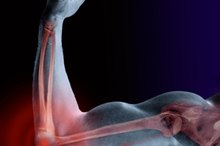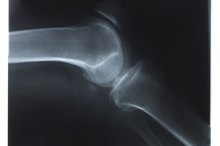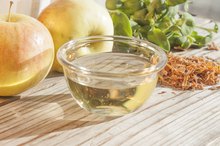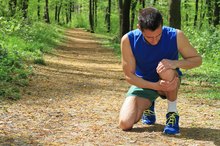Elbow pain is a common condition that often be attributed to sports or physical activities that require a continuous repetitive bending at the elbow joint. The skin around the elbow can become inflamed and sensitive to the touch with certain elbow conditions. If severe enough, the skin may even hurt or ache without any contact being made. Speak to your doctor if you develop sensitive and painful skin around your elbow.
If you are experiencing serious medical symptoms, seek emergency treatment immediately.
Bursitis
Bursitis is a common condition that develops around the elbow, as well as other joints, and can cause the skin to ache or become painful to the touch. Bursitis develops when small bursae sacs between the elbow joint and skin become inflamed or irritated. The sacs contain lubrication fluid and act as cushioning to encourage smooth joint mobility. The bursa at the elbow is known as the olecranon, which is located at the pointy end of the bones that meet at the elbow.
- Bursitis is a common condition that develops around the elbow, as well as other joints, and can cause the skin to ache or become painful to the touch.
- Bursitis develops when small bursae sacs between the elbow joint and skin become inflamed or irritated.
Causes
What Causes Fluid on the Elbow?
Learn More
Elbow bursitis can be triggered by a number of factors, including a fall or collision onto the elbow and enduring pressure placed on the elbow, such as from leaning with your elbow onto hard surfaces. Bursitis can develop instantly or over several months. A fall can spur bursitis relatively quickly, while concentrated pressure on the elbow can cause bursitis to develop over a prolonged period of time. Infection from an insect bite or wound can also cause bursitis, and medical conditions, such as rheumatoid arthritis and gout, often contribute to elbow bursitis as well.
- Elbow bursitis can be triggered by a number of factors, including a fall or collision onto the elbow and enduring pressure placed on the elbow, such as from leaning with your elbow onto hard surfaces.
- A fall can spur bursitis relatively quickly, while concentrated pressure on the elbow can cause bursitis to develop over a prolonged period of time.
Symptoms
The first symptom you will most likely notice if you develop elbow bursitis is swelling. If the condition worsens, the fluid sacs stretch and become painful. Touching your skin or placing pressure on your elbow can cause discomfort and pain. If bursitis continues to develop, bending your arm may become nearly impossible due to pain. Infectious bursitis turns your skin warm and red, which can also cause pain and discomfort. You may not notice the development of elbow bursitis immediately 1. Swelling may be difficult to recognize in its beginning stages as the skin on the back of the elbow is loose.
- The first symptom you will most likely notice if you develop elbow bursitis is swelling.
- If bursitis continues to develop, bending your arm may become nearly impossible due to pain.
Treatment
Fluid on Elbow Symptoms
Learn More
Speak to your doctor if you notice swelling on your elbow that won't subside. She may draw bursa fluid from your elbow and test it for bacteria or a medical condition. If the bursitis is caused due to an infection, your doctor may empty the olecranon bursa by drawing out the excess fluid with a needle. You may then need to take an antibiotic to help ward off further infection. If the bursitis is not infectious, self-care treatment, such as strapping on elbow pads and avoiding activities that place pressure on your elbow, may be enough to bring down the swelling. Certain anti-inflammatory drugs are also commonly prescribed in such mild cases. In severe bursitis cases, you may need surgery to remove the bursa completely. Your body grows new bursae sacs within several weeks.
- Speak to your doctor if you notice swelling on your elbow that won't subside.
- She may draw bursa fluid from your elbow and test it for bacteria or a medical condition.
Related Articles
References
- American Academy of Orthopaedic Surgeons: Elbow (Olecranon) Bursitis
- MedlinePlus: Bursitis
- Taylor SA, Hannafin JA. Evaluation and Management of Elbow Tendinopathy. Sports Health. 2012;4(5):384-393. doi:10.1177/1941738112454651
- Khodaee M. Common Superficial Bursitis. Am Fam Physician. 2017;95(4):224-231.
- Hubbard MJ, Hildebrand BA, Battafarano MM, Battafarano DF. Common Soft Tissue Musculoskeletal Pain Disorders. Prim Care. 2018;45(2):289-303. doi:10.1016/j.pop.2018.02.006
- Bracilovic A. Septic Bursitis. Veritas Health, LLC. Updated November 21, 2019.
- Blackwell JR, Hay BA, Bolt AM, Hay SM. Olecranon bursitis: a systematic overview. Shoulder Elbow. 2014;6(3):182-190. doi:10.1177/1758573214532787
- InformedHealth.org. Bursitis: Overview. Cologne, Germany: Institute for Quality and Efficiency in Health Care (IQWiG); 2006.
- InformedHealth.org. How can bursitis be treated? Cologne, Germany: Institute for Quality and Efficiency in Health Care (IQWiG); 2006.
- Patel J, Girishkumar, Mruthyunjaya, Rupakumar CS. Bilateral Olecranon Bursitis - A Rare Clinical presentation of Calcium Pyrophosphate Crystal Deposition Disease. J Orthop Case Rep. 2014;4(1):3-6. doi:10.13107/jocr.2250-0685.137
- Lockman L. Treating nonseptic olecranon bursitis: a 3-step technique. Can Fam Physician. 2010;56(11):1157.
- Sayegh ET, Strauch RJ. Treatment of olecranon bursitis: a systematic review. Arch Orthop Trauma Surg. 2014;134(11):1517-1536.
- Aaron DL, et al. "Four Common Types of Bursitis: Diagnosis and Management." J Am Acad Orthop Surg June 2011; 19:359-367.
Writer Bio
Dan Harriman began writing professionally in 2009 and has a varied background in marketing, ranging from sports management to music promotion. Harriman holds a Bachelor of Science in journalism with an emphasis on strategic communications from the University of Kansas and earned the International Advertising Association's diploma in marketing communications.







